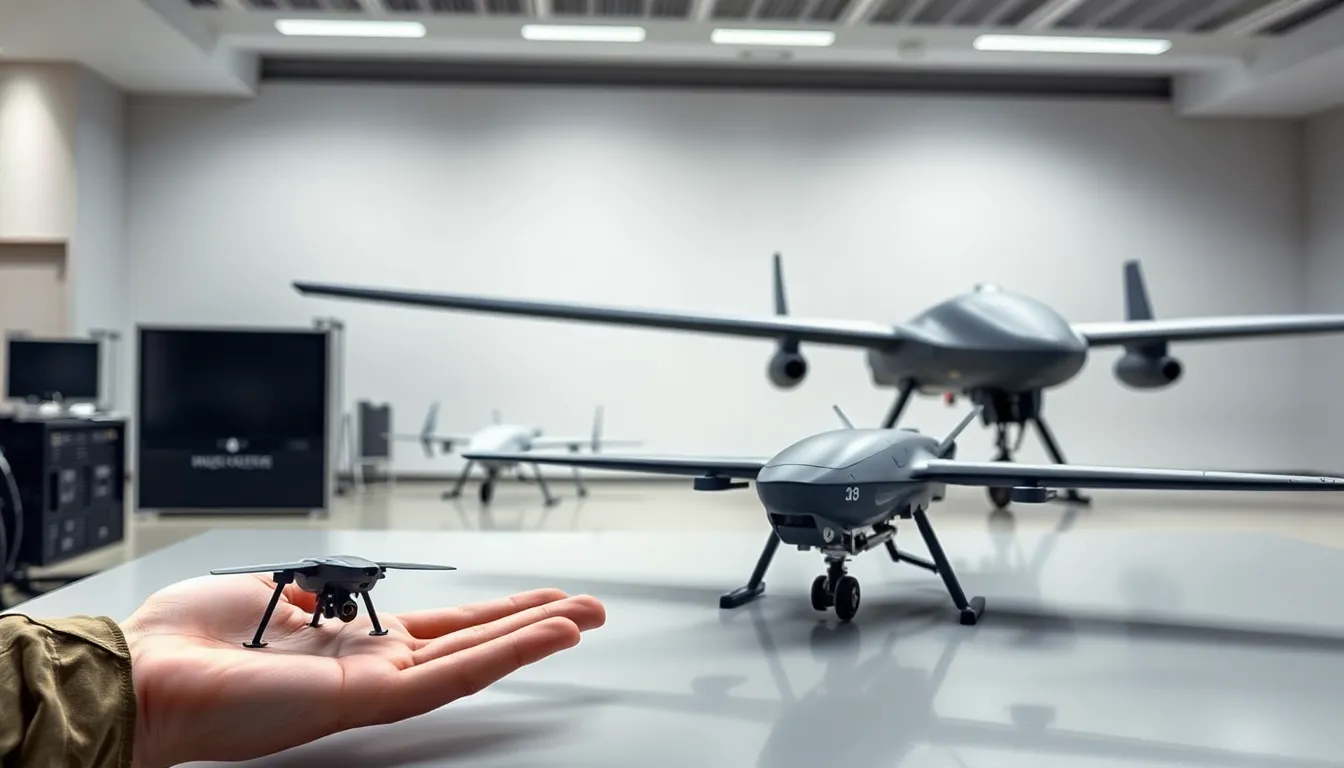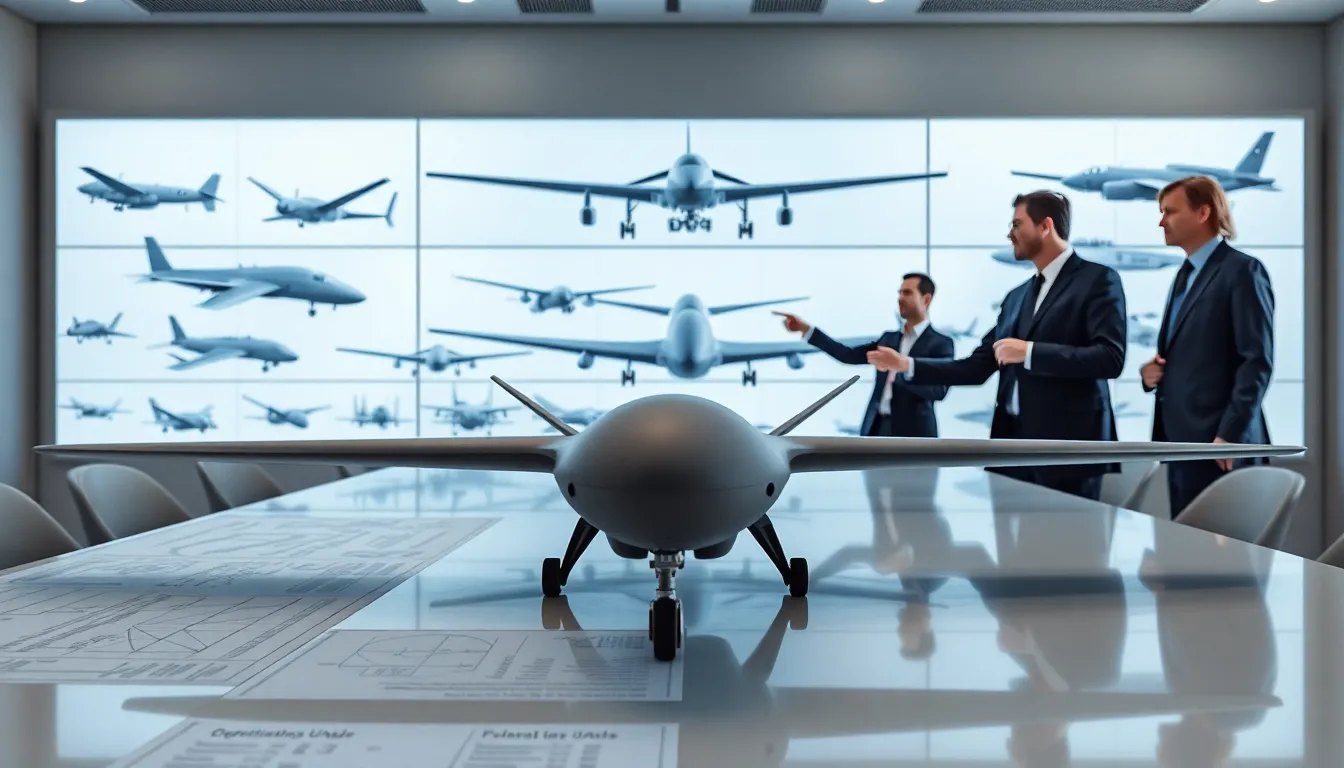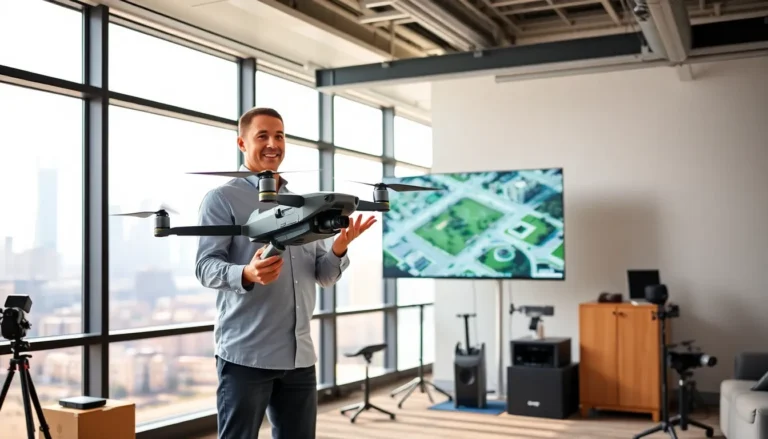When one thinks of military drones, images of sleek aircraft buzzing silently overhead often come to mind. But how big are these flying machines really? Spoiler alert: they’re not all the size of a small car. From tiny reconnaissance drones that can fit in a backpack to massive unmanned aerial vehicles (UAVs) that rival traditional aircraft, military drones come in all shapes and sizes. Join us as we investigate into the intriguing realm of military drone sizes, and trust us, it’s more varied than a family reunion.
Table of Contents
ToggleTypes of Military Drones

Military drones can be classified into several categories, each designed for specific missions. Here’s a quick overview:
1. Small Drones
These diminutive UAVs are often used for reconnaissance and surveillance. Examples include the Raven and Wasp drones, which can easily fit into a soldier’s pack. Small drones may weigh as little as 2-20 pounds and are usually equipped with cameras and sensors to gather intelligence.
2. Medium Drones
Larger than their small counterparts, medium drones like the MQ-1 Predator are primarily used for surveillance and strike missions. These UAVs typically range from 100 to 1,000 pounds and can stay in the air for extended periods.
3. Large Drones
When people think of military drones, they often picture large UAVs. The MQ-9 Reaper, for example, is a behemoth that can weigh over 10,000 pounds. These aircraft can carry various payloads, conduct surveillance, and perform strike operations.
4. Combat Drones
Some military UAVs are specifically designed for combat. These giants may reach sizes comparable to manned aircraft, like the Northrop Grumman Global Hawk, boasting a wingspan of over 130 feet and an impressive flight range.
Summarizing, the size of military drones varies widely, corresponding to their individual missions and capabilities.
Size Range of Military Drones
The size of military drones can range from those weighing just a few pounds to international titans. Let’s break it down:
- Nano Drones: These tiny marvels often weigh less than 2 pounds and can easily be handheld. Used for reconnaissance, they can be deployed in both urban and rural settings.
- Small Drones: They generally weigh between 2 to 25 pounds and are designed for quick missions.
- Medium Drones: These UAVs typically weigh between 100 to 1,000 pounds. They’ll often have a wingspan between 20 to 40 feet, striking a balance between size and capability.
- Large Drones: Ranging from 1,000 to 25,000 pounds, large military drones can have wingspans from 50 to well over 100 feet. The aforementioned MQ-9 Reaper exemplifies this category.
- Giant Drones: Think of the Global Hawk, which, in terms of size and capabilities, rivals some traditional military aircraft. With a wingspan that exceeds 130 feet, these drones can traverse vast distances for surveillance and reconnaissance missions.
When assessing the size of military drones, context is key. From stealthy reconnaissance missions to airstrikes, the varying sizes of drones enable militaries to choose the right tool for the job.
Factors Influencing Drone Size
Several factors determine the size of military drones:
1. Mission Requirements
Different tasks often require different drones. Surveillance might demand smaller, stealthy drones, while combat missions often necessitate larger platforms capable of carrying heavy payloads.
2. Operational Environment
Drones deployed in urban areas must be smaller to navigate tighter spaces. Conversely, those used in open combat zones benefit from larger ranges and payload capabilities.
3. Technological Advancements
As technology evolves, it allows for smaller drones to carry more sophisticated equipment, potentially decreasing the need for larger vehicles. Innovations in light-weight materials and battery technology can greatly influence the design and size.
4. Budget Constraints
Military budgets can impact drone size. Smaller drones generally cost less to develop and operate, making them appealing for certain missions.
5. Payload Type
The size of the drone is also contingent upon what it’s required to carry. Drones tasked with carrying missiles or additional surveillance equipment must naturally be larger.
6. Endurance and Range
Larger drones can often stay aloft longer due to greater fuel capacity. This aspect can be crucial, particularly in surveillance missions that require sustained observation.
Comparison of Military Drones to Civilian Drones
While military drones often steal the spotlight with their imposing size and advanced capabilities, it’s fascinating to compare them to civilian drones:
1. Size Variation
Civilian drones start from tiny toy-sized copters to bigger commercial UAVs used for agriculture or photography. For instance, a consumer drone used for aerial photography might weigh around 2-10 pounds, while commercial agricultural drones can weigh up to 25 pounds.
2. Purpose Distinction
Military drones are designed for specific tactical operations like surveillance or combat. Civilian drones often serve recreational, agricultural, or logistics purposes.
3. Technological Capabilities
Military drones typically incorporate cutting-edge technology, such as advanced sensors, communication systems, and payload capabilities. Civilian models generally offer basic features like GPS and cameras without the same sophistication.
4. Regulatory Oversight
Military drones operate under defense regulations and are not subject to the same airspace constraints as civilian drones, which must comply with strict regulations and licensing requirements.
To conclude, while the ethos of drone technology bridges both military and civilian applications, the size, capabilities, and purpose starkly contrast.
Future Trends in Military Drone Size
As technology continues to advance, the future of military drones appears to be shifting:
1. Miniaturization
There’s a trend toward miniaturization. Advances in materials science and engineering may yield even smaller drones equipped with high-tech surveillance capabilities. The next generation of drones could shrink while enhancing their functionalities.
2. Increased Autonomy
With the evolution of artificial intelligence, future drones may become more autonomous, allowing smaller drones to perform complex missions previously reserved for larger units. Imagine an army of small drones coordinating on surveillance missions without human oversight.
3. Swarm Technology
The concept of drone swarms could take flight. These are groups of drones that work autonomously to achieve a mission. This trend emphasizes quantity over size. Smaller, interchangeable drones could diffuse costs and enhance operational flexibility.
4. Hybrid Models
Future drones may increasingly feature hybrid designs that combine capabilities of small and large models, offering versatility in size and function.
5. Enhanced Payload Capabilities
Models might also be developed to carry heavier loads even though smaller sizes due to advances in technology, ensuring that even the tiniest drones can support complex missions.





